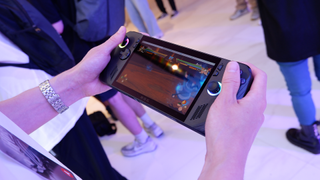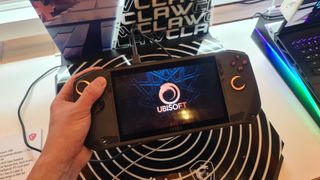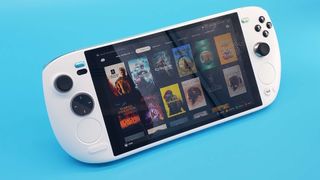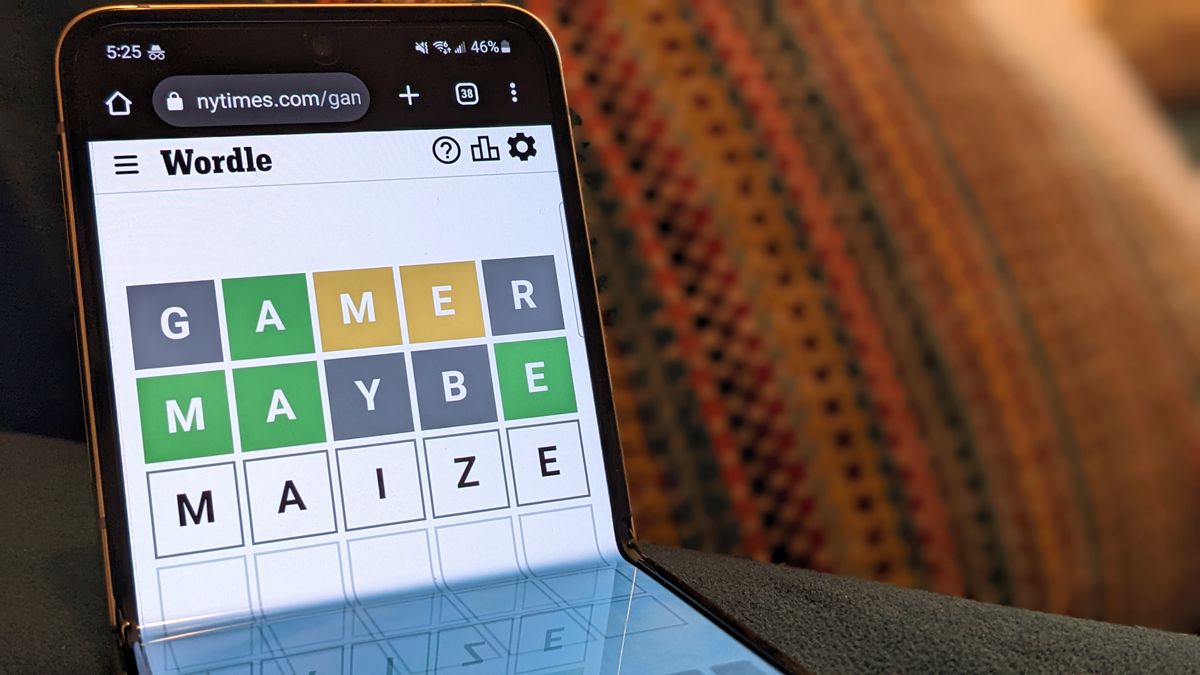If you told me five years ago that we would have a cost-effective way to play PC games on a compact handheld without compromise I never would have believed you. While it was technically possible to take your titles with you, these machines were usually incredibly pricey and only available in niche quantities (usually crowdfunded) making them not ideal for a wider market. In 2024, however, the opposite problem is true as more hardware manufacturers are vying for an increasingly slight slice of the handheld PC pie.
What brought the handheld PC gaming scene to the mainstream most was Valve’s Steam Deck which was first announced in August 2021. Unlike pricier rivals from companies like OneXPlayer, Ayaneo and Ayn, three of the larger boutique manufacturers, Valve aimed to keep the price down at the cost of resolution and raw gaming power. For reference, we gave it 85% in our Steam Deck review from early 2022 and praised its versatility despite a weak screen and a less-than-stellar battery life. Its widespread commercial and critical success opened the floodgates for competition to surface.
The gap was present because of the quirks of the Steam Deck, which also plague the vastly superior Steam Deck OLED to a lesser extent. That’s because this handheld could only run games that were available on Steam, or were compatible with Linux as the handheld is fuelled by SteamOS and not something more universal than Windows. You can play a vast majority of your Steam library on this handheld, with Valve smartly implementing a Deck Verification system, denoting when a title is unsupported, playable, and verified with in-house thorough testing.
For the vast majority of people, it’s going to be enough. If you buy a Steam Deck OLED today, you’re getting hands down the best available display with a 1,000,000:1 contrast ratio, HDR, and 1,000 nits brightness which make up for the lower 800p resolution present. That’s where the gaps were starting to show and where other manufacturers seized the opportunity.
The Asus ROG Ally was originally revealed as an April Fool’s joke before becoming available in June 2023. We described it as the “next-gen Steam Deck” for its more powerful performance courtesy of the Ryzen Z1 and Z1 Extreme chipsets, 120Hz refresh rate, and Windows’ wider software support.

If you’re talking about the best handheld gaming PCs available, those two fit the bill nicely. The latter machine supports the likes of PC Game Pass, Ubisoft Connect, Epic Games, GOG, and other launchers for a more encompassing selection with a higher resolution of 1080p. But what about if you wanted an even better screen? Well, there’s the Lenovo Legion Go, which keeps everything that made the Ally a success, but adds a Nintendo Switch-like quality with its detachable controllers and bumps the resolution up to 1600p with its 8.8-inch display. Not quite as good as its competition, as you can’t often game in its native resolution owing to the limitations of the Z1 chip. However, that’s three valid options from trusted manufacturers, but then things got complicated.
Fast forward to 2024 and it’s become more challenging to separate the wave of incoming handheld gaming PCs by their USP. For example, we got our first look at the MSI Claw earlier this year, with many outlets reviewing the machine in March and April. It was generally disliked by critics for its buggy software and high price tag, even surpassing the sticker price of the Lenovo Legion Go ($800) with less to offer. Armed with an Intel Meteor Lake and Arc graphics, it tried to go all in on Team Blue, but couldn’t quite stick the landing.
In my own hands-on with the MSI Claw at a press event in March, I instantly noticed the step down in build quality, display, and compatibility of some of its competition. Being more expensive than the Steam Deck OLED, Asus ROG Ally, and Lenovo Legion Go from the offset isn’t a good start, especially when games looked and ran as poorly as they did. Simply put, some titles wouldn’t launch, and others would suffer performance issues; greatly disappointing considering this was MSI putting its best foot forward.

Not a great start, but the Taiwanese manufacturer wasn’t done yet. Enter the recently unveiled MSI Claw 8 AI+ which made its first appearance at Computex 2024 earlier this month. Merely three months after releasing its first handheld gaming PC, comes the next iteration, this time running a Lunar Lake processor with an improved 80Wh battery and a 120Hz eight-inch display. It’s going to run Battlemage (Xe2) graphics and looks to be an out-an-out improvement. While it’s expected to be released towards the end of the year, it begs the question of exactly why the hardware company decided to launch a vastly inferior product only to show the next-gen off in no time.
The MSI Claw and Steam Deck aren’t the only handheld gaming PCs to receive an upgrade. Enter the Asus ROG Ally X slated for release next month. It features a larger 80Wh battery and an improved SSD than the original with other mid-generational ergonomics tweaks to the design. There’s also a bump up to 24 GB LPDDR5X RAM at 7,500 MT/s, some of the fastest memory in the form factor, which could drastically improve gaming performance in 1080p with the same Z1 Extreme chipset at the helm.
While these mid-generational upgrades are alluring, they call into question the longevity of some of these handheld gaming PCs. As a frame of reference, it’s only been around two and a half years since the Steam Deck was released, and competition is showing no signs of slowing down. That’s because there’s also the Zotac Zone revealed at Computex 2024 as well; another 1080p performer, this time with an AMD Ryzen 7 8840U CPU and 780M integrated graphics.
Our hands-on revealed a decent enough feel in the hand, with a neat 7-inch AMOLED display, but we weren’t totally convinced about how it would stack up against its growing list of rivals.
For those counting, that’s a total of eight handheld gaming PCs announced or released by these five manufacturers in two and a half years which works out to a new device every four months give or take. I think that’s grounds for over-saturation, especially as we’re seeing mid-generation revisions in such a short period. The booming scene is burning bright, but if it continues on this trajectory then things are going to burn out fast.

When you introduce too many products to market in such a short time frame, you run the risk of confusing consumers and weakening confidence in your product. Anyone who bought an MSI Claw A1M is liable to feeling disappointed at the reveal of the AI 8+ mere months later, and the same can arguably be said about the jump from the Asus ROG Ally to the Ally X. Yes, the PC hardware scene moves fast, but these innovations are far quicker than what we see from the best graphics cards and other key components in your build.
With all said, we can turn our attention back to companies like Ayaneo which are serving a more enthusiast-level side of the market. The Ayaneo Kun won some favor with us for its great looks, dedicated software, responsive controls, and combination of AMD Ryzen 7 7840U with 780M integrated graphics. However, at $1,329 for the spec we reviewed, it’s on a different wavelength to other handhelds I’ve mentioned above.
This has driven rapid growth in the handheld Windows PC sector.
CEO of AyaneoArthur Zhang, CEO of Ayaneo, spoke to us about the emergence of competition in the handheld gaming space: "The biggest change undoubtedly lies in the increasing market size and attention."
"As mobile chip performance advances rapidly and gaming scenarios and habits undergo significant transformations, this has driven rapid growth in the handheld Windows PC sector."
Valve, Asus, MSI, Lenovo, and now Zotac and even Adata are moving in on the space it has occupied since 2020, with things only destined to heat up further.

Ayaneo releases a wealth of products in a short duration but with vastly different form factors. This includes not only the more traditional Kun, but also the Slide, 2S, Air Plus, and Flip DS.
"We can dig deep into the needs of gamers for handhelds from different perspectives, and thus launch different sizes and shapes of Windows handhelds to satisfy the segmentation needs of the gamer community."
They feel there aren’t enough products catering precisely to their preferences.
CEO of AyaneoWhat helps companies like this stand out is the customization. You can choose how much RAM you want in your machine, occasionally even picking between different CPUs at varying prices, too. As more companies muscle in on this space, more innovation may be needed to have a chance at success.
"For these gamers, they don’t consider our product launches excessive; instead, they feel there aren’t enough products catering precisely to their preferences and needs."
That’s where we find ourselves in the summer of 2024. It’s still such an early time for an emergent scene, it’s not quite clear whether these devices are here to stay or simply part of an incredibly lucrative phase. With so many handhelds hitting the shelves, a crash could be on the horizon if companies aren’t careful. As consumers, we either want the best value for money, the highest level of performance possible, or something unique. However, I believe we’re already at the point where there’s too much on the market now, with further iterations offering less and less as time progresses.

 2 days ago
24
2 days ago
24








